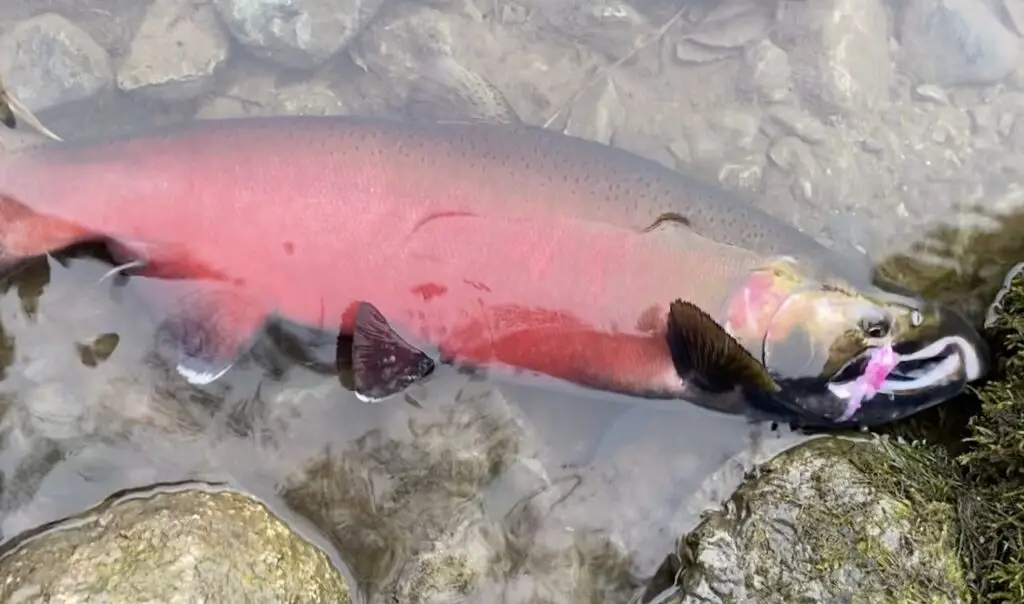
Coho salmon are the primary angler-target salmon species with the greatest abundance and reach all over the PNW.
While chinook salmon are often sought after with more intensity, nothing creates the level of angling opportunity and the ability to convert that to dinner like the coho salmon.
Chinook in many river systems lose their culinary desirability (mature and turn dark) quite quickly and in some cases enter the river in a shape that makes them unlikely to be retained.
The coho salmon will be harvestable for many more river miles typically then chinook, making it the backbone of many river salmon fishing angler opportunities.
This salmon fishing resource page is all about how to catch coho salmon in these freshwater / river opportunities.
If you’re looking for more ideas about catching coho salmon in saltwater, you can head over to our page on Puget Sound salmon fishing. Also, below is a video you might find helpful on catching coho salmon in saltwater environments.
I would say on balance, that river fishing for coho is far more of a challenge than catching them in saltwater.
River fishing for salmon basics
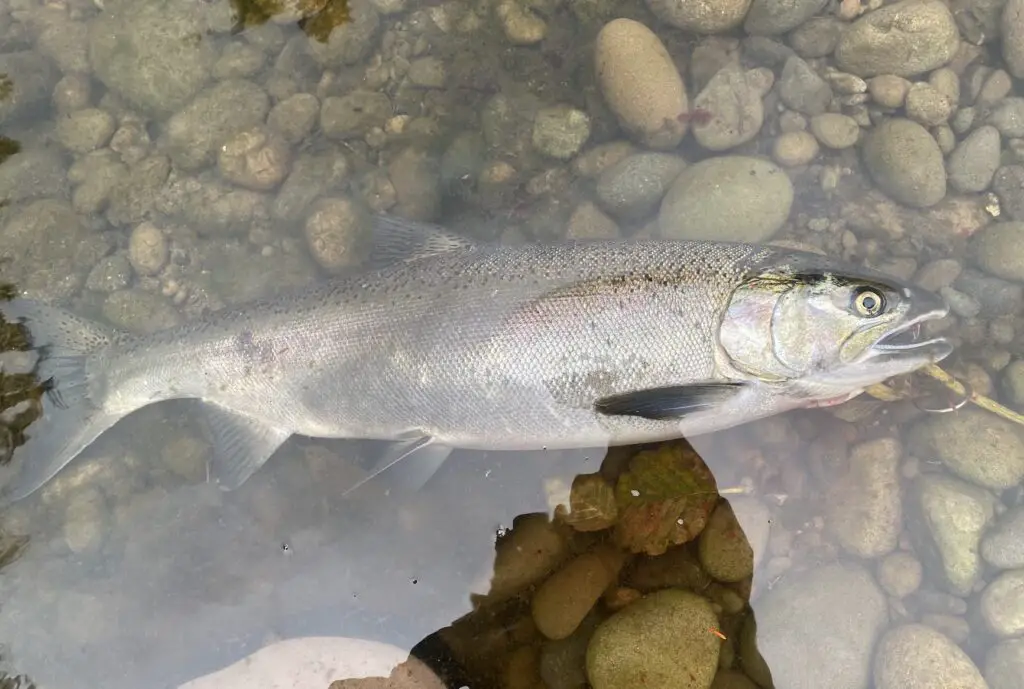
There are many basics (and advanced tips!) to river fishing for salmon that I cover here, that you should review, but I will also try to summarize them briefly as well on this page.
This page will be more focused on coho salmon as a subset of river fishing for salmon knowledge.
One of the most important and often first things I explain to new salmon anglers is that salmon stop eating when they’re in freshwater.
Their existence as a calorie-consuming machine slows down and then stops entirely somewhere between saltwater staging and freshwater entry.
The sexual organs begin to mature and displace all other bodily activity of the migrating salmon.
What this means is that generally speaking, the goal in salmon angling as opposed to other types of angling doesn’t involve using terminal gear that imitates the primary food source of the salmon.
Now it is true that we will still get salmon to bite in the freshwater on stuff that imitates small bait fish or we will get them with plug-cut herring and a variety of other techniques, however, that is not always the best way or an effective method at all in some cases.
I like to divide the approaches to river salmon angling as appealing to a salmon’s sense of smell and taste, vs trying to trigger an aggression strike.
What angling techniques work best for coho salmon in rivers?
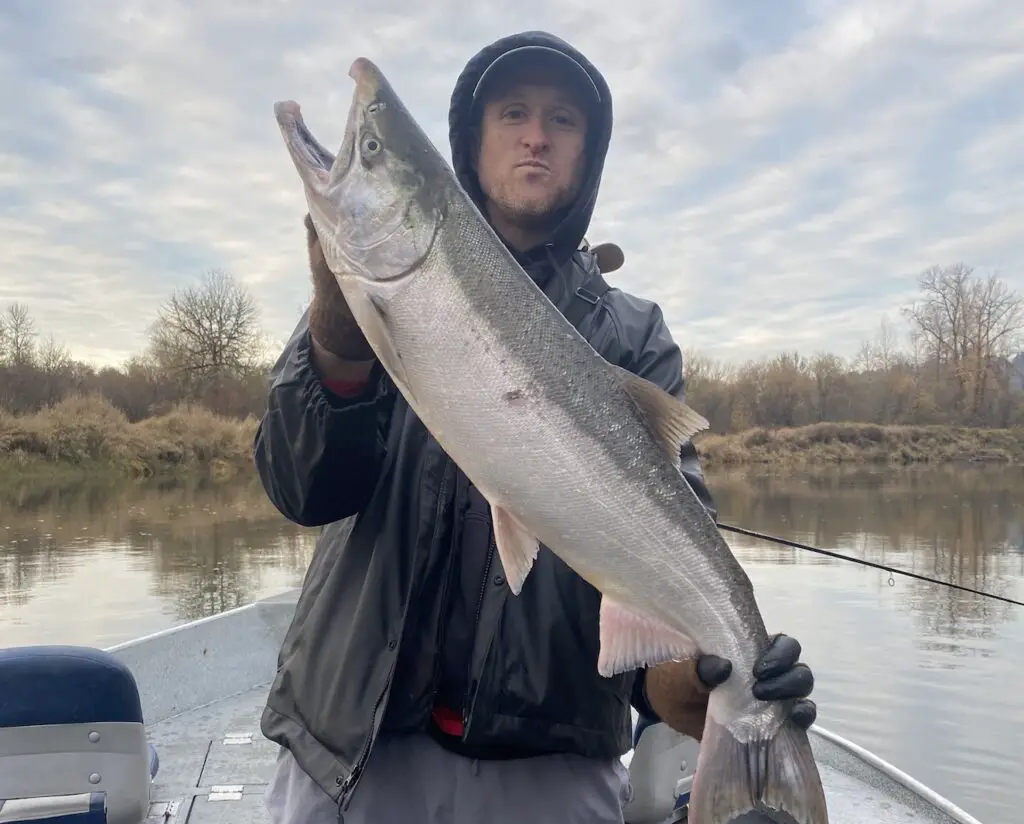
One of the great joys of fishing for coho salmon in the river is their proclivity to bite out of aggression on a variety of lures.
There is simply nothing like feeling an aggressive take from a coho salmon on a spinner, jig, or plug when that rod is in your hand and you are directly connected to the salmon.
However, it’s also important to realize that a coho or any salmon will only strike out of aggression in specific scenarios.
If those scenarios are not present in the river you are fishing, you might have more fun throwing rocks in the river than making cast after cast at uninterested salmon.
In fact, coho are legendary, LEGENDARY for their temperamental nature that leads to inexplicable periods of not biting on ANYTHING! I’m using obnoxious all caps here to denote the level of crazy, fishing for coho salmon can drive you when things are not lined up.
My 3 favorite techniques to use when fishing for coho salmon from the bank, in a pair of waders are:
- Spinner fishing
- Twitching jigs (scroll down to twitching jig section). Also, here’s a video on the topic.
- Float fishing with eggs
I have specific pages devoted to each technique, linked above, but I will describe them a little bit here as well.
What are the best river conditions for coho salmon?
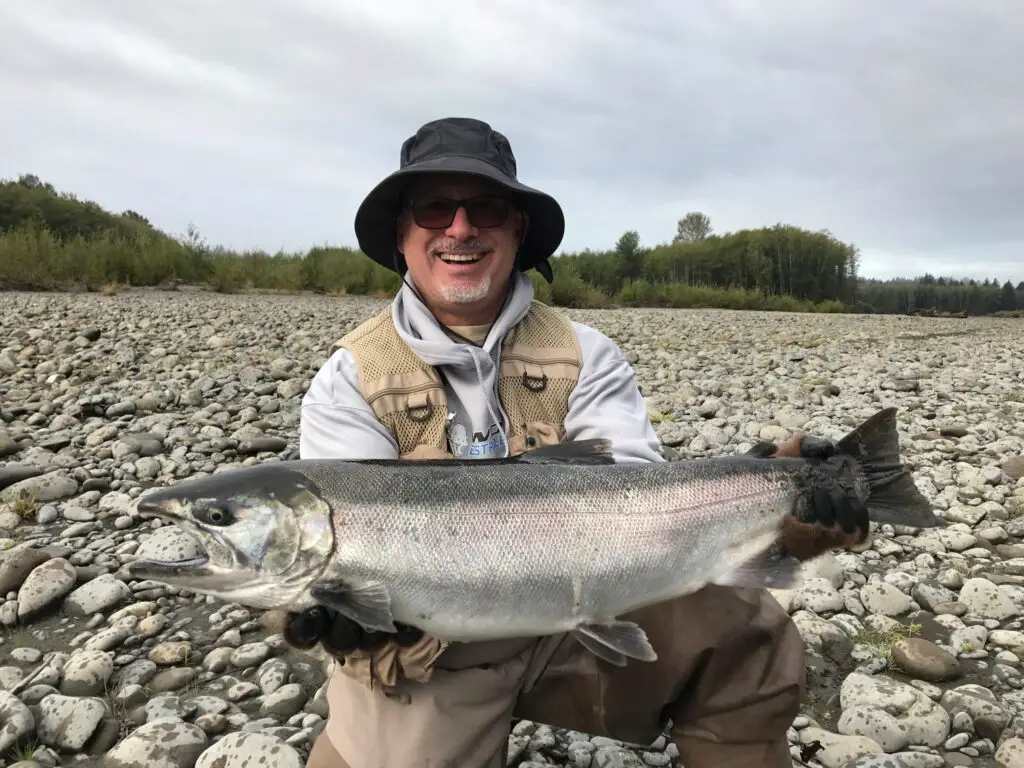
All three techniques require that coho salmon “feel safe”.
How does one know how a coho salmon feels? Let me put it this way, if a big school of coho are holding in crystal clear water with anglers casting at them and ripping their lines through the school, you will not get coho to bite in those conditions.
Additionally, coho salmon need to be “fresh”. I’m not talking about necessarily about recently having been in saltwater although that helps, but more the idea of being fresh to the spot you are fishing.
If the water level has been dropping for a while at your favorite crick or perhaps holding steady at a level that’s very difficult for coho to move up through, you will find massive pockets of coho salmon that are “stale”.
Meaning, they haven’t moved in a long time, and have become so acclimated to their surroundings that, like your teenage child, they are just tuning you out and nothing you say will reach them.
So we need coho salmon that are moving up the river system, but not blowing through in the case of rapidly rising water.
We also need coho salmon which have ample cover, either in the form of structures that hide them such as logs, rocks, and a massive stump, or deep enough or fast-flowing enough water to hide them.
What kind of water do coho salmon spend time in?
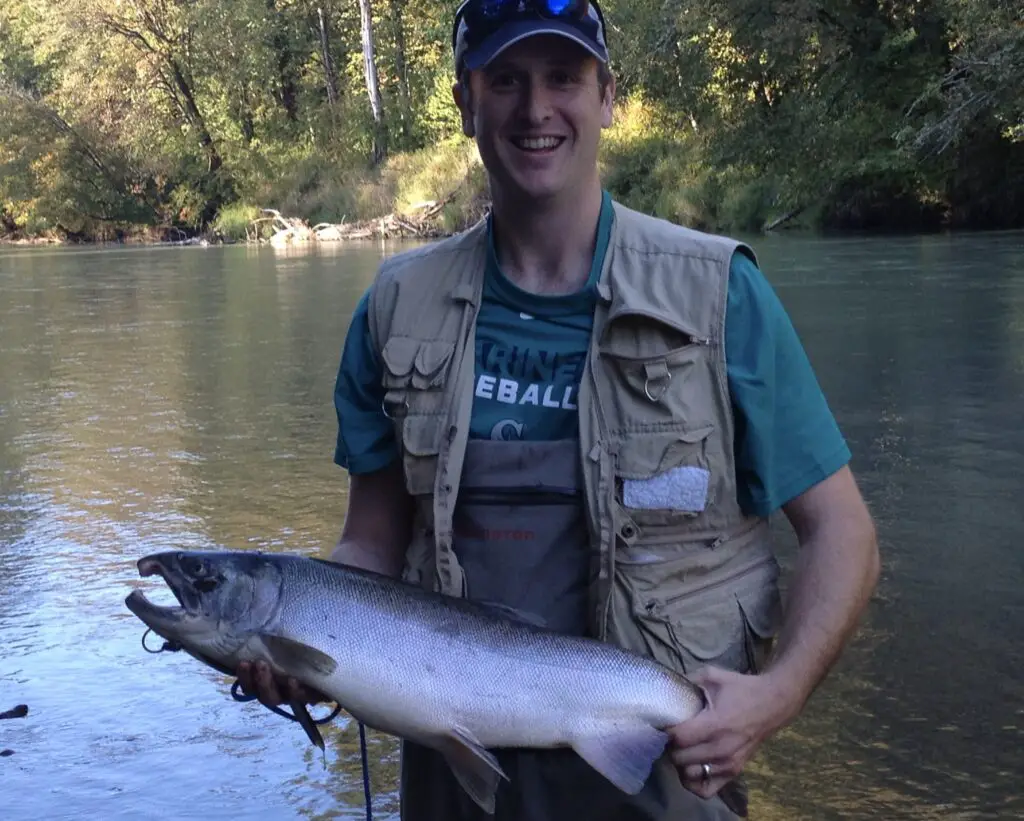
You can find coho salmon just about anywhere in a given river, however, they will certainly prefer some types of water to others.
The first thing to realize about coho salmon beyond needing to have water that provides ample protection is that these are some lazy fish.
Yes, you can find them in the same drifts as their larger and more physically powerful cousins (chinook salmon), but that will often only be the case if that’s the only place that offers the needed protection.
Coho love to congregate in slow-moving pools, back eddies, soft pocket water on the edges of fast-flowing water, seams, and lower portions of a drift (not quite the tail-out).
Sometimes we call this non-moving water frog water, and it can be a great place to target coho.
What’s the best way to fish for coho salmon?
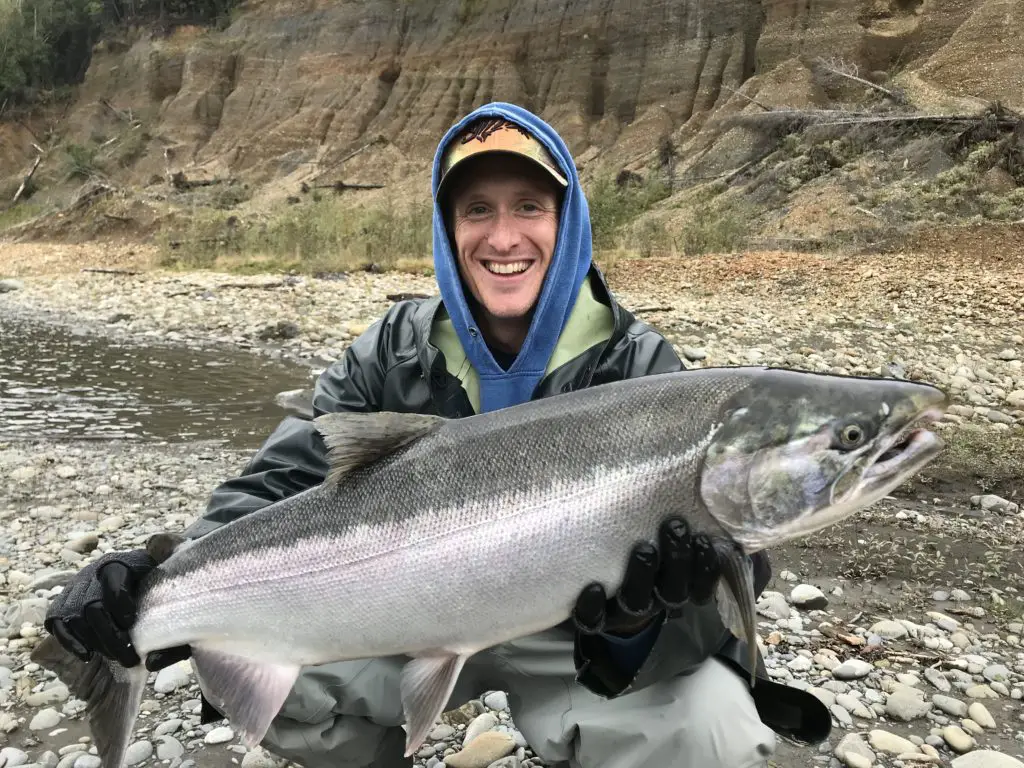
Let’s start to put all of this together.
The first step is to make sure the river you intend to fish has the right water level (or will have the right water level!) before you ever make plans to go coho fishing.
This can be different for each river, but there are some general guidelines that apply to all rivers.
Sometimes (often?), anglers approach coho fishing with the idea of “I’m going to travel to wherever the best coho fishing is at” versus just fishing one river only when it’s in the optimal condition.
If you are the traveling type or in the traveling mood, checkout the below video for some ideas on how to approach things.
But, let’s simplify this for some rules about approaching any given river.
- Is there a run of coho on the river?
- Do the regulations allow you to fish for them?
- Are you allowed to retain any coho or only hatchery? Otherwise known as “selective fishing”
- Where in the run timing cycle is the run of coho?
- Is the water level ideal and holding steady or dropping?
Here are a few examples to illustrate why these questions are important and in the correct order:
I want to fish River X, so I first go look at the regulations for River X on WDFW’s website or perhaps PNWBestLife.com has a page for it.
I see that River X allows the retention of all coho.
Next, I want to see if River X has a hatchery. Again, I could go to the PNWBestLife.com page for River X and look at the run timing graphs and escapement graphs to learn a lot about the river.
I also can find these escapement reports and see if River X is listed there under the coho section.
I see that River X has 1000 coho on the escapement report, and the previous week it had 300.
A year ago, the run finished at 5,000. I might surmise that we are right in the middle of the coho run this year at this exact point in time.
Now, I’m looking at water levels for River X on the USGS website. I see that the river is at a fishable level, but has been dropping for 7 days, and is holding steady.
Most likely, what I will find when I go fishing the river for coho are some nice schools of coho salmon that haven’t moved up very quickly.
I might find darker fish (bright red like the title picture), but I also might find the coho less aggressive and less willing to bite.
In my experience, the technique that takes advantage of the most aggressive salmon is spinner fishing.
In fact, if you know what you’re doing, you can often hook aggressive coho salmon on the first properly presented spinner cast.
That’s because they will seek and destroy that spinner from 5+ feet away sometimes, which means you often don’t even need to make the perfect cast.
Now, in the case of fishing river X, I would be expecting spinners to not work as well because these coho would be less aggressive.
Twitching jigs can take advantage of less aggressive coho, though the technique still requires they have protection to be aggressive enough.
The more effective technique for less aggressive coho is often fishing with eggs under a float.
When that doesn’t work, I suggest diving into the water and grabbing them with your bare hands!
I recently fished with the exact scenario described in River X and I found a pile of coho in the water I would have said was too fast for coho to want to hold in, but because the river was low, it was the only place which offered protection.
The water was moving and was only about 3-4 ft in depth, but these cohos would aggressively take my eggs under a float on just about every other cast.
In fact, I was convinced I was being bit every cast, just oftentimes not hard enough to convert to a hook-up as I saw my float briefly get bumped or go under for a split second and my eggs damaged on nearly every cast.
These same coho completely ignored my spinner and jigs.
I’ve gotten coho to bite on spinners when they are more stale, but you need fairly still water so you can present the spinner as slowly as possible while continuing to allow the blade to spin.
The same goes for twitching jigs. The slower the water, the more effective you will be at targeting stale coho.
What’s the best gear for targeting coho in the river?
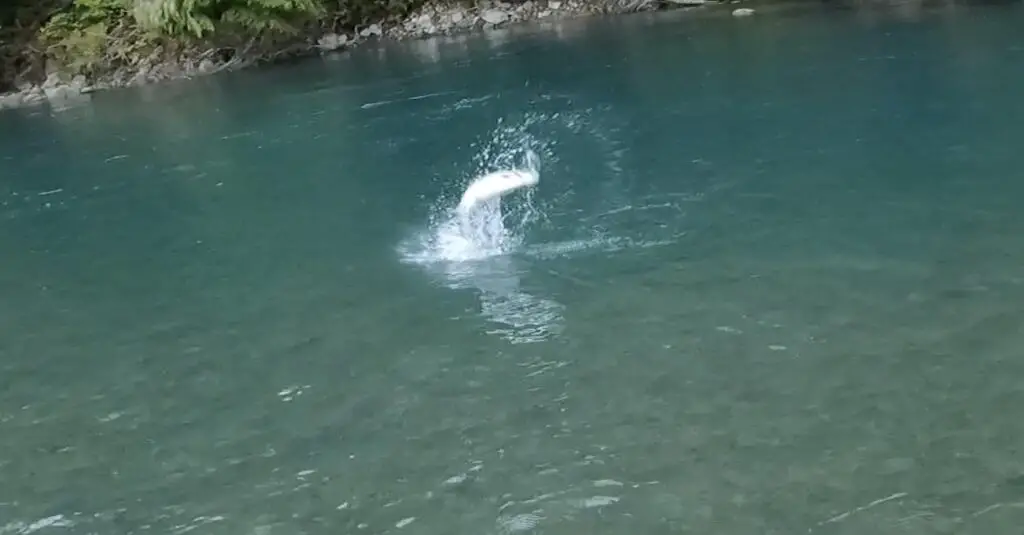
It is ultra important to have the right rod and hooks for targeting coho. Particularly in rivers that have requirements on barbless hooks, you are not going to get a chrome spazzing out coho to the bank on too heavy of a rod.
I’ve experienced it, I’ve watched it. Coho after coho getting off of gear that just isn’t dialed in for coho fishing.
Here are a few factors to consider:
- The power of the rod ideally is Medium-Light to Light.
- Action can be fast or slow depending on the technique, but I’ve found slower action to be more helpful in keeping Coho hooked
- Rod length is typically 7’6 to 10’6, but more based on technique. I prefer 9’6 for spinners, 7’6 for twitching jigs, and 10’6 for float fishing.
- The drag of the reel needs to be set so that the line can be pulled out with moderate effort. A bit less than for Chinook.
- The hook tine needs to be smaller. Use thinner wire hooks or smaller-size hooks. 2/0 would be my max in many cases.
A primary reason to use smaller hooks is because of the lighter rods. Using a large hook with a light rod will result in many missed hook-ups due to not enough penetration into the jaw of the coho salmon.
Too heavy of a rod will result in the rod not absorbing the spastic twists and moves of a fresh coho.
In the case of something having to give, it will be you, giving the coho back to the river as it swims off safely.
I’ve written a lot about these topics on my best fishing rod for salmon blog post. Also, best fishing reel for salmon and steelhead.